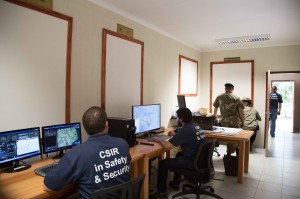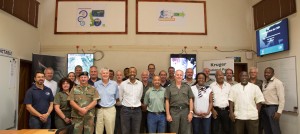“2015 is the year in which the war on rhino poaching will be won or lost.” This is according to Major General (retired) Johan Jooste, Commanding Officer for Special Projects for the South African National Parks (SANParks). The CSIR has taken up the challenge to ensure that the best possible scientific and technological tools contribute to the protection of these natural resources. The latest intervention is the establishment of a mission-area control centre near Skukuza in the Kruger National Park.
Jooste describes the situation as “an onslaught on our natural resources”. “We are in trouble,” he commented; “It is unabated and it is relentless and 2015 is a critical year.”
During 2014, some months have seen up to 50 poachings recorded in the Kruger National Park alone and the annual number of rhinos poached was 1 215 countrywide. In January 2015 more rhinos have been poached than any previous month.
CSIR and SANParks team up

A technical CSIR team oversees the use of a customised CSIR-developed system where information is analysed, collated and disseminated for operational use.
In 2013, the CSIR entered into an agreement with SANParks to render specialist technology support over five years in several tactical, operational and strategic programmes. The CSIR supported SANParks in writing and developing a proposal for the Howard G. Buffet foundation, securing a donation of R255 million to invest in improved counter poaching capabilities. These capabilities include airborne systems for mission support, surveillance systems to ensure maximum levels of awareness; canine training aids and systems, as well as ranger equipment and training to ensure that personnel are optimally equipped to help counter poaching.
A substantial part of the CSIR’s contribution lies in expertise in day and night surveillance, systems integration, communication and data collection and analysis, defence technology and tactics for specialised reaction force deployment. It also includes systems that detect human movement, border crossing and the origin of gunshots.
An important outcome of the CSIR and SANParks partnership is the establishment of a mission-area control centre in the Kruger National Park, situated in the so-called intensive protection zone where rhino poaching levels are the highest. The facility operates as the nerve centre, where surveillance reports, data about poaching events and border crossings and other information is collated and displayed. Otch Otto, Mission Area Manager, Special Projects in the Kruger National Park says, “The difference between us and them (rhino poachers) is our intellectual capacity, our information technology capability and communication. They can also track and walk and shoot. We are on par. Except for this centre.”
Various Arms of Services and departments have representation in the centre where a number of communications and information technology tools as well as maps are at hand.

CSIR executive board members attending the opening of the operational centre in the Kruger National Park
Dr Sibusiso Sibisi, CSIR CEO, accompanied by members of the CSIR Executive, travelled to the Kruger National Park late last year as the first visitors to the centre. During the event, Sibisi confirmed the CSIR’s ongoing support to counter-poaching efforts as a key focus area.
At the mission-area control centre, data (voice, visuals, radio reports, etc.) are analysed to detect trends and consistencies. According to Cobus Venter, a senior systems engineer at the CSIR, the aim is to move to a pro-active stance to start pre-empting poaching attempts. “There is a lot of modelling we can do with the data and statistics to predict when poaching can occur,” he explains. “The system is a means of collating data from different sources so that one has a complete picture and enough data on which to base decisions and develop the plans – to ultimately outwit syndicates.”
A technical team oversees the use of a customised CSIR-developed system that is used to log surveillance content from sensors, and reports or information from rangers, Park officials and tourists – who are encouraged to be vigilant about suspicious behaviour. Chris Serfontein, CSIR Technology for Special Operations Manager says, “The short term focus is to assist SANParks in designing and implementing an integrated risk management system where all poaching related information is analysed, collated and disseminated for operational use. The effective tactical application of ranger capabilities is critically reliant on accurate, actionable intelligence.”
The centre forms part of an arsenal of countering activities that include upgraded ranger posts, packs of trackers, training of a small group of specialised reaction forces, electronic fencing and aerial surveillance.
Rangers are a special focus of many of the projects, aimed at improving mobility, clothing and protection, equipment and weapons. Research is also undertaken on the mental agility of rangers that are exposed to the stress and cruelty of environmental crime.
The CSIR’s longer-term focus is to build capabilities in environmental asset security management and support the safeguarding of endangered species. The organisation’s role lies in assisting agencies mandated to operate in this field with the evaluation or adaption of technologies, integrating systems or devising solutions or inventions to do the job optimally. Furthermore, research is also done on a whole-of-society approach, to align the effected stakeholders, neighbouring communities, law enforcement agencies and the industry.
Why specifically the rhino?
Rhino horn – and specifically poached rhino horn – is viewed as a status symbol. The powdered substance is believed to have medical health benefits. Increasingly other parts of the animal are also removed, including ears, bones, eyes, genitalia and shards of skin for cultural belief and natural medicinal purposes.
Rhinos are easy targets as they have poor eyesight and are not aggressive by nature. Rhino calves are often killed or maimed, because they do not run from an attack. They would repeatedly storm poachers in an effort to protect the maternal adult – with dire consequences. Other animals are also under threat. Poachers often shoot hippos, mistaking them for rhinos in poor light.
Working towards a real solution

CSIR research looks at various options to improve mobility, clothing and protection, equipment and weapons, as well as assist with training of specialised reaction forces.
Multiple solutions have been proposed from around the world on how to deal with the problem, ranging from shock tactics, scare tactics and flooding the market to legalising the trade and poisoning the horns. However, almost all solutions offered are met with many more obstacles. Serfontein says, “There simply are not enough rhinos in the world to satisfy the demand; rhino horn is the one commodity for which the demand will grow if the value decreases, as more consumers will be able to afford it.”
In line with the CSIR’s collaborative mode of working, several partners contribute systems, information or support to the project. These include the Department of Environmental Affairs, the Department of Safety and Security, provincial and regional parks, private reserves, Southern African Development Communities, industry partner SeeCrypt, as well as non-governmental organisations such as the Howard G. Buffet Foundation, World Wildlife Foundation, the Peace Parks Foundation and StopRhinoPoaching.com.
For more information, please contact dpss@csir.co.za
